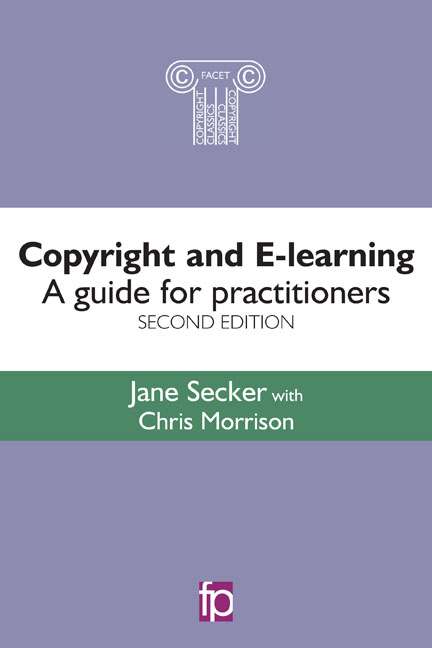Book contents
- Frontmatter
- Contents
- Figures, tables and case studies
- Preface to the second edition
- Introduction
- Abbreviations and acronyms
- Glossary
- 1 E-learning and copyright: background
- 2 Digitizing text-based content for delivery in a VLE
- 3 Using digital media: video, images, sound and software
- 4 Copyright issues and born digital resources
- 5 Copyright in the connected digital environment
- 6 Copyright education and training
- 7 Conclusion
- Further resources
- Index
4 - Copyright issues and born digital resources
Published online by Cambridge University Press: 08 June 2018
- Frontmatter
- Contents
- Figures, tables and case studies
- Preface to the second edition
- Introduction
- Abbreviations and acronyms
- Glossary
- 1 E-learning and copyright: background
- 2 Digitizing text-based content for delivery in a VLE
- 3 Using digital media: video, images, sound and software
- 4 Copyright issues and born digital resources
- 5 Copyright in the connected digital environment
- 6 Copyright education and training
- 7 Conclusion
- Further resources
- Index
Summary
Introduction
This chapter focuses on what is sometimes called ‘born digital’ content. The term is used to refer to content that is both created and made available in digital format, such as web pages, word-processed documents, academic journals and e-books. It includes content available through subscription databases (behind a paywall) and content made freely available on the open web, but is in contrast with material that is digitized from print (analogue) format for either preservation or access reasons. This chapter will also discuss the copyright and IPR issues associated with institutionally owned digital resources, for example teaching materials that are created specifically for use in online learning, such as online tutorials, online quizzes and other ‘learning objects’, and digital content created by students as part of their course.
In reality a lot of content produced today such as music, images and video is born digital, but this chapter focuses largely on text-based content. While the law does not distinguish between material created in digital or analogue format, the use of born digital content is usually subject to licences that govern what those in educational establishments can do with the content. Those wishing to make the best use of the content for teaching purposes need to understand the relationship between licence agreements and copyright exceptions. In several countries around the world (including the UK) the law now states that copyright exceptions, such as copying for the purposes of non-commercial research and private study, cannot be overridden by licence agreements. The interaction between copyright exceptions and licences makes it more important that teachers understand what they are permitted to do with digital content as they come to use it for their teaching. It is often technically straightforward to incorporate the material into an online course, either through linking to it, or uploading it into the VLE. However, the ease with which people can copy or re-use digital content is not necessarily reflected by a corresponding awareness or comfort with the copyright or licence implications of doing so. The situation may be further complicated as some subscription resources use DRM technology to restrict how the content can be used. The case study in this chapter is from the copyright officer at the University of Auckland. It highlights the Course Reading List Service at the University of Auckland and how this helps to manage copyright compliance.
- Type
- Chapter
- Information
- Copyright and E-learninga guide for practitioners, pp. 123 - 162Publisher: FacetPrint publication year: 2016



